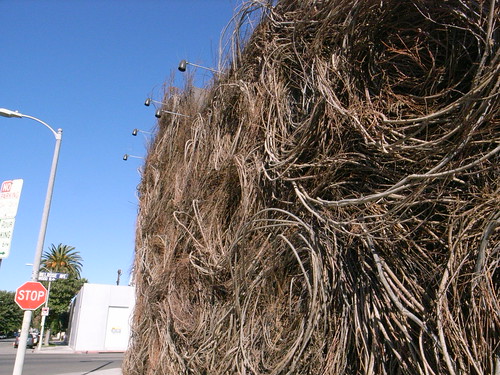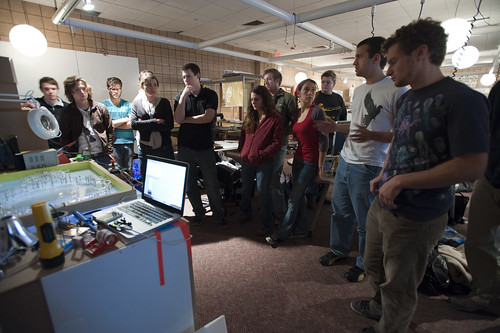A week spent last in the Nordic EU discovering the knots and twists and snarls and kinks of the imbroglio that goes along with executing on damn good design. On the one hand there was the work of workshops meant to work *upon the work; on the other hand, there are the traces that appear as — if illuminated by forensic investigators UV light — the trails of interconnected relationships, goals, aspirations, roadblocks, paths of hope, begrudging words, encouraging words, optimistic personalities and personality disorders, cues and clues as to how things work, or how they do not; who talks to who, and who does not; where things can get done, and where they will not, despite everything. Very intriguing. Certainly not unusual activities; just the analysis and awareness that comes with trying to understand, and that from the perspective of a science-technology-studies kind of person. It’s like being inside a Latourian analysis of the making of things. I should draw a map.
Continue reading Weekending 12122010: Clarity via Complexity
Category: Actor-Network Theory
Five Advantages of The Concept of "Design"
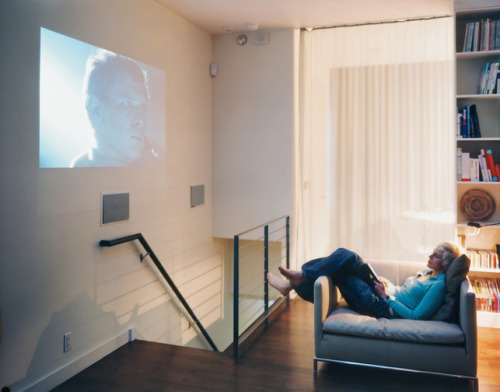
The Unhappy Hipster site has the tag line “It’s Lonely In The Modern World” dryly shifting design toward self-mocking irony. Perhaps a kind of denaturing of the sublime intoxication home/interior/architectural design was once able to effect. Seasoning this with Latour, we might wonder if there ever was a modern world and if there were not — have we ever been lonely?))
I read — closely, but not obsessively — this essay by Bruno Latour that was delivered as a keynote at the Networks of Design meeting of the Design History Society in 2008. I pretty much read whatever Latour writes, and listen to whatever he discusses in lectures where available. Mostly because he can be insightful while also being funny, and there aren’t too many philosophers who can make that claim. But also because I find his work mostly relevant, or I make it relevant to this ongoing project of understanding design and comprehend how design is a way to circulate and create knowledge through the materialization of ideas. ((The bedrock of this project is a bit of science-technology studies, which is how I came across Latour some decade or so ago, a hobbled appreciation of actor-network theory, and my infantile understanding of the questions surrounding this “object-oriented ontology” thing.))
So, when Latour has an essay that proposes *a few steps toward a philosophy of design, I figure I should give it a look-see.
The Week Ending 04092010
It was an insane week on the side of things happening between homes..a move. Number 3 on the list of the most traumatic things that can happen in life, I’ve been told. ((I may’ve misheard, but it made sense at the time, so I’ve assimilated that as a part of the life’s-trauma-list.))
On the side of things happening in and around the Nokia Studio and the Home Laboratory there were some fun, curious things.
Plastic Happens
To go along with the previous *blog all dog-eared pages* post, an additional description of *what plastic is* — to include alongside of all the others chemical, political, economical, historical, technical, medical, fictional, &c — done in the story-told style, again from a dog-eared page in Richard Powers’ *Gain* — a fictional industrial historical novel of a soap-making company alongside the memoir of those implicated in its adventures to make the world clean, we find this formula:
Plastic happens; that is all we need to know on earth. History heads steadily for a place where things need not be grasped to be used. At a shutter click, a bite-sized battery dispatches a blast through a quartz tube filled with halogens. Excited electrons, falling back down the staircase of available energy states, flash for a second, to dissipate the boost that lifted them briefly into rarefied orbitals. This waste energy bounces off the lines of a grieving face and back down the hole of the aperture, momentarily opened. Inside, reflected light ruffles the waiting film emulsion like a child’s hand impressing a birthday cake. Years from now, metal from the flash battery will leach into runoff and gather in the fat of fish, then the bigger fish that eat them.
Why do I blog this? I like these adjunct descriptive-formulae for things that reframe things in contexts as suited-for and as relevant as what one might typically consider *the* description. Plastic may almost always be framed as in the context of its chemical properties, or chemical architecture. Perhaps also in its marketing terms — how it is sold, or how to frame it as a useful, beneficial part of one’s life. Which of its many varieties can be recycled, which is often never *just* an aspect of its chemical properties, but also a municipal decision or even a legal ordinance that dictates that it *must* be recycled if it is sold in a specific geography. An so on. These multivalent, multiple terms that *are* what make something what it is — their ontological furniture of all sorts, not just the habitual, common-place or “common knowledge”, but those valences of a thing that go alongside of it as well, that are as material and as relevant as the proto-typical and everyday. Perhaps even more relevant, as the Powers’ passage above suggests. More everyday and experienced rather than the rarefied industrial-chemical.
Can these alternatives provide a more legible basis for telling a story about something, and do so in a way that is more meaningful and with deeper, thicker, world-changing impact?
Continue reading Plastic Happens
Thickly Imbricated
I just finished Richard Powers’ intriguing industrial historical novel Gain, which was brought to my attention by a couple of passages in Bruno Latour’s Reassembling the Social
, which was brought to my attention by..&c.
One of the passages in the Latour is a sidebar in which he deploys an extended quotation from Powers in order to capture the multivalent prismatic network of associations that invigorate what a corporation is. There are no singular definitions — there are associations of the firm from a legal perspective, from the perspective of the guy working on a loading dock, from the point of view of shareholders who own lots of a company, and those who only own enough to have a modest retirement (they hope), from the perspective of environmental activists, from a historical point of view in the sense of corporate history, or a historical point of view from the perspective of labor history — and so on. The multivalent identity of a corporation is a complex thing, and even more complex to represent.
In this quotation, Powers’ captures the complexity of the corporation in a wonderfully succinct fictional historical moment. We’re in the denouement of the novel. The Clare company has come from a rich history of family enterprise in the American colonial days to today. Starting as an intrepid candle making trio (two Claire brothers and an Irish widower who is a candle craftsman) to a multinational, multiproduct conglomerate. As the CEO prepares for an interview on public television about this storied company, he ponders a question the producer has asked him to consider, jotting notes on a legal pad.
To make a profit. To make a consistent profit. To make a profit in the long run. To make a living. To make things. To make things in the most economical way. To make things for the longest possible time. To make things that people need. To make things that people desire. To make people desire things. To give meaningful employment. To give reliable employment. To give people something to do. To do something. To provide the greatest food to the greatest number. To promote the general welfare. To provide for the common defense. To increase the value of the common stock. To pay a regular dividend. To maximize the net worth of the firm. To advance the lot of all the stakeholders. To grow. To progress. To expand. To increase knowhow. To increase revenues and to decrease costs. To get the job done more cheaply . To compete efficiently. To buy low and sell hight. To improve the hand that humankind has been dealt. To produce the next round of technological innovations. To rationalize nature. To improve the landscape. To shatter space and arrest time. To see what the human race can do. To amass the country’s retirement pension. To amass the capital required to do anything we want to do. To discover what we want to do. To vacate the premises before the sun dies out. To make life a little easier. To make people a little wealthier. To make people a little happier. To build a better tomorrow. To kick something back into the kitty. To facilitate the flow of capital. To preserve the corporation. To do business. To stay in business. To figure out the purpose of business.
Kennibar thinks of adding: “To beat death,” but he’s afraid he’ll forget what he meant when the cameras roll this afternoon.
Richard Powers. Gain: A Novel. p. 398
What is the relevance of this? In part, reflecting upon the capability of a good story teller to capture a richness that escapes even the most well-researched corporate histories. In this sense, the power and force of the well-written word resonates with the sensibilities of “design fiction” to convey an idea, a concept, a *new thing* or even an *old thing* in a more compelling way than wireframes and storyboards.
Latour makes this point in an earlier passage — the wonderful dialogue chapter between the student and his professor — when the persistently baffled and obstinate student fights the losing fight for *objectivity*, not realizing that this moves him so far away from his material, from his site of curiosity that he conveys nothing but clichés. And in part the dialogue encouraged me to find this book, Gain.
S: But certainly nothing is objectively beautiful — beauty has to be subjective…taste and color, relative…I am lost again. Why would we spend so much time in this school fighting objectivism then? What you say can’t be right.
P: Because the things people call ‘objective’ are most of the time the clichés of matters of fact. We don’t have a very good description of anything: of what a computer, a piece of software, a formal system, a theorem, a company, a market is. We know next to nothing of what this thing you’re studying, an organization, is. How would we be able to distinguish it from human emotions? So, there are two ways to criticize objectivity: one is by going away from the object to the subjective human viewpoint. But the other direction is the one I am talking about: back to the object. Positivists don’t own objectivity. A computer described by Alan Turing is quite a bit richer and more interesting than the ones described by Wired magazine, no? As we saw in class yesterday, a soap factory described by Richard Powers in Gain is much livelier than what you read in Harvard case studies. *The name of the game is to get back to empiricism.*
Why do I blog this? A question of the the how and why of conveying material and ideas and histories in a way that is both empirical and with the powerful disbelief-suspension mechanics of a good story. Using fiction to do the work of designing as well using fiction in the work of communicating design that moves away from silly knee-jerk assumptions about what is “good” or what will make a profit. What is conceptual and innovative beyond the borders of ho-hum least-common denominator kruft?
Continue reading Thickly Imbricated
Innovation and Design

I’m reading two books at once, a dangerous thing to do because one is always interpreted alongside the other, changing what it may have been and my perspective, necessarily. But, in hindsight I would say that I am doing this on purpose. One of the books is Reassembling the Social: An Introduction to Actor-Network-Theory (Clarendon Lectures in Management Studies) by Bruno Latour, which I am reading for the second time. The other book is Design Driven Innovation: Changing the Rules of Competition by Radically Innovating What Things Mean
by Roberto Verganti, which I only bought because of the suggestive, business-y title and because business books are things I can make short work of during a 5 hour airplane flight. You know — they basically tell you everything you discover in the title, and then repeat it for no more than 200 or 250 pages, only with snap-to-grid, spic-and-span examples.
* Skip right on past my rambling to my executives’ summary *
What could be the relationship between a noted sociologist-of-associations and a tailored-suit-with-french-cuffs-wearing business professor / management consultant? Perhaps nothing useful. But, one of the roughly constructed graphics in Verganti’s book resonated with Latour’s notion of the collective — and it was even described as a drawing of “a collective research laboratory” — and being a good Latourian, I had to follow the links in my head. These are just some sticky-notes between these two books and my own interest in the role of design in changing things, as well as the ways that organizations can be led by design sensibilities or design studios, rather than engineering efforts and accounting principles. Both are things that are lurking below the surface of these two books, Verganti more explicitly than Latour.
Continue reading Innovation and Design
Props, Prototypes and Design With No Spec: Notes on Heliotropic Smartsurfaces
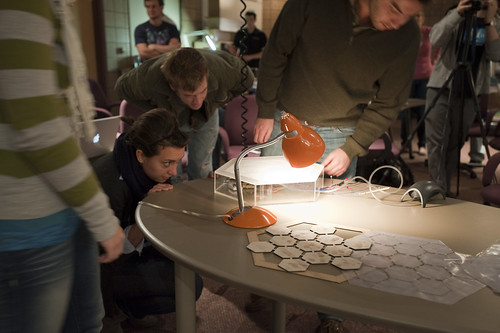
What did I learn from visit to “M” — University of Michigan — and the School of Art & Design, Taubman College of Architecture + Urban Planning? Two things, mostly.
First, huge universities in tiny midwestern towns, with really big footballers really only need one letter to stand in for themselves.
Second, the importance and relevance of props to communicate an idea – a reinforcement of the significance of objects that always contain ideas and possibilities and thereby play a role in the expression of the future. I am perhaps misguidedly and with reckless-abandon reading and practicing both design and actor-network theory..at the same time.
What follows are some scraps and notes, mostly around a combo of two things: design fiction props and the virtues and challenges of design without specification.
After a lecture Thursday night and a bit of a lecture Friday morning, I participated in the Smartsurfaces studio (which also has blog and is run by John Marshall, Karl Daubmann and Max Shtein.
Is there a reluctance to design with partial specifications? Routinely, one can assume that there is development and design first, then there is execution. As if they are distinct “phases” of design work. I understand the tendency — I mean…I’m an engineer. You specify, describe an interface and then just go ahead and build it.
But what about building as specification? Or making to define the specifications and the design principles, and the stories? And doing this over-and-over again, redoing things and refining in the process of making — even making away from the screen?
Normally, one might ask when given a “project”:
What are we going to do?
What are we going to make?
The tenses are all mucked up.
What about instead, when given the chance to project into some near future:
What are we now making?
What are we doing now?
Designing through partial-reflections and partial-knowledge and partial-specifications as a conglomerated design-develop-execute activity — a continuous iterative doing. Brewing and creating controversy in the midst of things — making things not possible, or impossible, or highly speculative, or disagreeable. Or moving with full confidence in the face of overwhelming vagueness and excruciatingly deserted requirements documents.
Perhaps starting from the end — as if the design has been unearthed in the future, by an archeologist who laminates meaning on the thing. Introducing fictional explications with all the seriousness of science-fact making. Creating an object and saying — this is what it is, it is a heliotropic smartsurface and it means these things, and had been used to do such-and-so.
This is the sorts of questions and concerns that make the Smartsurfaces studio so intriguing. I welcomed the opportunity to participate. It is keeping me thinking.
Let me describe one of the team’s presentations as a way to explicate some of these ideas.
As described in their presentation, Team 3 had started its heliotropic smartsurface project with an offering by one of the team members of a Hoberman Sphere as a prop to accrete ideas and focus the effort. The team created an articulated 2-D sculpture borrowing mechanical idioms from the initial Hoberman Sphere prop. It was a mechanical, moving object consisting of many connected armatures that collectively formed a giant figure-8 lying flat on a smooth surface that was, I would guess, about 1.5 feet x 2.5 feet. The entire assemblage was articulated by a stepper motor with two bobbins that spooled monofilament. The spools turned via the stepper motor. On the spools and running through a simple network of small bobbins, the monofilament line gathered the armatures in such a way that one or the other side of the figure-8 was pinched closed or pulled open. One spool of monofilament ran to around to one side of the It was described that this could lead to a surface that let sunlight in or blocked it off. The control mechanism was a Macbook connected to an Arduino with a light sensor. The Arduino also controlled the stepper motor. An earlier prototype had been constructed using chipboard as the main component of the armatures. This chipboard prototype was not as durable as the demonstrated version which consisted of clear plastic for the armatures. The spooling posed a problem on occasion and had to be tended-to. It was pointed out that this was one of the main problems with the assemblage. The spools were not reliably gathering the monofilament and keeping it neatly coiled on the bobbins that were attached to the stepper motor. The team had ‘burned out’ a couple of Arduinos along the way to this presentation. They had to borrow a larger stepper motor from one of the studio professors a few hours before the project reviews.

Demonstration. A flashlight creates the effect of the Sun beams on a sensor connected to an Arduino, connected to a Macbook connected to a stepper motor. Sensor readings are interpreted by firmware in the Arduino’s microcontroller. This then sends control signals to the stepper motor and articulates the armatures via spools attached to the stepper motor which run through bobbins on either side of the box the whole thing sits in.
Team 3’s presentation was a very refined, complete, articulate and functionally robust design. It was seductive to watch the mechanism and listen to the quite articulate description of the process. It was a clear, thoughtful bit of work and the detailed construction was impressive.
My remark — and it was only for the productive discussion, and not a dismissive criticism by any means — was to focus on this point about the spooling being finicky, requiring tending during the demonstration. In my own interpretation this was the ‘main problem’ the team faced — a remaining point to ‘work through.’ In fact, it was barely seen as a problem in my eyes. It was an excuse for the presentation, or a begging-of-forgiveness for this distraction of a team member stepping to the assemblage and tugging on some monofilament or fussing with the kit.
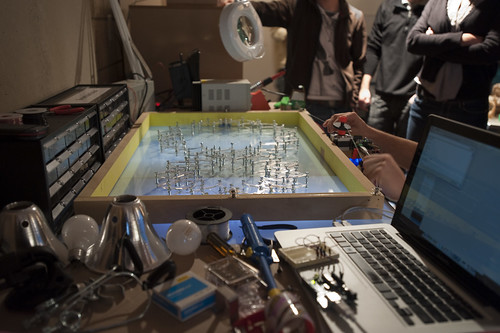
The ‘problem’ as an issue to be addressed is that the spools don’t spool the monofilament consistently. Things get a bit tangled up and the issue is handled with a bit of hand-work to get the assemblage back on its feet.
This is a side-issue in a sense. It’s not even really a problem in the sense that it is something that can be easily figured out. After all, spooling monofilament is a black box at this point — an intermediary of sorts. The ‘problem’ no longer exists — this is something that has been solved, closed off, handled already so it’s just a matter of extracting one of those ‘black boxed’ solutions (e.g. by traveling to the world of sewing machine design, fishing rod reels, ships-anchor-mechanisms, &c.)
The use of a stage prop to frame their design/discussion work of what is being done, or what could be done seemed to move this team from a broad range of possible design-expressions of a ‘heliotropic smartsurface’ into a specific thing whose materialization had a form that could be pointed to — the Hoberman Sphere prop. The prop provided a seed that could crystalize a material goal.
Setting a goal in terms that allows iteration and rethinking and, perhaps most importantly — failing — in the design process open up the possibility of unexpected possibilities. Which is to say the possibility of making things different from what might be expected, or pre-supposed. The tactic comes with maturity and the no-fear sense that, no matter what, things will happen and get ‘done.’
What I might say here is that there could have been more intense failure in the midst of all this. Either failure or iteration. The design ended up as a 2D Hoberman Sphere, just as specified from the beginning.
It is a useful design strategy to not expect/specify a particular, instrumentally functioning, pre-specified thing as the ‘final conclusion’ in the process of designing. When introducing the Hoberman Sphere, I believe this very talented group defined their conclusion with the evidence of this presupposed vision of the designed future being, in my Latour-infested mind, this point that the remaining issues are few, or perhaps even just one point of fixing the spooling issue.
As a tactic for designing new things, my own preference is to allow for the possibility that the thing in the end will become something different along the way, so that where you end up may not be where you thought you would conclude. Each moment in the process evolves into its own refresh and re-invigoration of possibilities. The design is never done. There is no hard distinction between ‘research’, ‘exploration’, ‘design’, ‘development’, ‘execution’ — &c. The Gantt Chart attempts to organize and marshall phases that tick into other phases ultimately reaching a conclusion. It won’t help create new things — there are no gaps, no bumps, the future is determined with no opportunities for explicit failure or remaking or starting-over-again.
Why do I blog this? Some notes to reflect on the challenges of design without stepping through a ladder of design-development-execution. Flattening these hierarchies and combining the action of making/destroying/failing/refining as design itself.
[[Thanks to my hosts, John, Cezanne Charles, Karl, Malcolm McCollough, Amy Catania Kulper, &c. and all the wonderful students in Smartsurfaces.]]
Continue reading Props, Prototypes and Design With No Spec: Notes on Heliotropic Smartsurfaces
A Manifesto for Networked Objects — Cohabiting with Pigeons, Arphids and Aibos in the Internet of Things
One of my pieces of “output” from the workshop on Blogjects/Networked Things that Nicolas and I put together is the document contained herein. (BTW, we’re very close to having our more formal workshop “write-up” completed.) It started out as some scribblings on what I learned from the workshop, seeing the groups’ projects, and so forth. It then grew into more of a polemic as I recognized what were some consequential stakes — why things would matter, or help, if Things were networked? Why would I want a world such as that? And how would I design interactions for such a world?
I didn’t want to lay low and play the engineer who might just geek out on the technology behind networked Things (I do.) I didn’t want to lay low and play the social scientists and just geek out on theorizing or studying how engineers make and how social beings interact in a world of networked Things (I do that, too). I wanted to start by creating a near-future kind of technology fiction about one particular set of design goals for a world in which networks pervades space and social practice and in which networks are co-occupied by slightly differentiated social beings — us and Things.
What would I want from such a pervasively networked world? A better bead on what the state of that world is that is impactful. Hence, my stumbling about trying to describe a world of networked Things that aren’t only around to help track packages, but are around to help create a world-wide accessible register of various real-time “feeds” of macro and micro states of the social and ecological environment.
This is not complete and the translation of my ideas to a progression of articulate words sometimes feels like someone who slips on the ice for about 20 minutes and refuses to give up the struggle and just fall down to save themselves the mounting embarassment.
Abstract: The Internet of Things has evolved into a nascent conceptual framework for understanding how physical objects, once networked and imbued with informatic capabilities, will occupy space and occupy themselves in a world in which things were once quite passive. This paper describes the Internet of Things as more than a world of RFID tags and networked sensors. Once “Things” are connected to the Internet, they can only but become enrolled as active, worldly participants by knitting together, facilitating and contributing to networks of social exchange and discourse, and rearranging the rules of occupancy and patterns of mobility within the physical world. “Things” in the pervasive Internet, will become first-class citizens with which we will interact and communicate. Things will have to be taken into account as they assume the role of socially relevant actors and strong-willed agents that create social capital and reconfigure the ways in which we live within and move about physical space.
To distinguish the instrumental character of “things” connected to the Internet from “things” participating within the Internet of social networks, I use the neologism “Blogject” — ‘objects that blog.’
Technorati Tags: blogjects, RFID, The Internet of Things, world 2.0, world2.0



